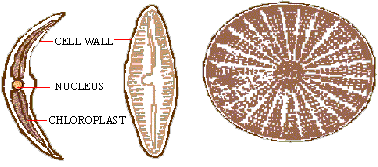|
PinkMonkey Online Study Guide-Biology
3 Evolutionary precursors of complex life forms
Protista is a diversified assembly of different groups
of organisms which includes:
(A) Unicellular algae-like protista, e.g. Diatoms, Dinoflagellates etc.
(B) Fungi-like protista, e.g. slime molds
(C) Animal-like protista, e.g. protozoa
(A) Diatoms
These are microscopic, usually single-celled or colonial forms. They are found both in fresh water and salt water. In ocean they occur in vast assembly as floating plankton. They show a variety of patterns showing extreme beauty and symmetry because of which they are sometimes called "jewels of the plant world."
 Figure 14.21 Diatoms
Figure 14.21 Diatoms
General account : The cell is made up of two overlapping,
ornamental halves fitting together like two petri dishes. The cell is
composed of silica and manganese instead of cellulose. It is uninucleated
with ribbon-like plastids, containing chlorphyll-a, chlorophyll-c, beta-carotene
and oxanthophyll. They store food as oil and polysaccharides other than
starch. The locomotion is of gliding type produced by the streaming of
cytoplasm through raphae or grooves on the surface of the cell wall. There
are two types of forms, viz. pinnate with bilateral symmetry, and
centric with radial symmetry.
Common life-cycle : Diatoms are diploid. They
reproduce asexually as well as sexually. In asexual reproduction it divides
by mitosis in which two valves are separated, each cell receiving one
valve of the parent cell. Each of the two cells forms a new valve fitting
into the old one. Thus, the size goes on reducing during repeated mitotic
division. At a certain stage the protoplast escapes to form two haploid
gametes by meiosis. These gametes fuse to form diploid zygotes called
auxospores which increase in size to compensate for the reduction, before
the new cell wall is laid down. Thus, the life-cycle shows the alternation
of diploid and haploid generations.
Common examples are Pinnularia and Navicula.
Economic importance : (1) The diatoms play an
extremely important role in the aquatic food web. They are the most abundant
component of marine plankton forming the primary food source of marine
animals.
(2) The imperishable siliceous cells of diatoms are led down in various habitats. When dead, they form thick deposits of diatomaceous earth which is used as an ingredient in many commercial preparations such as detergents, polishes, paint removers, insulators, for decolorizing and deodorizing oils and also as fertilizers.
(3) Being abundant, they help in releasing oxygen and maintaining the oxygen cycle.
|
Diatomaceous earth
The imperishable, siliceous dead cells of diatoms
do not disintegrate but form thick deposits called diatomaceous
earth or diatomite. It is procured from exposed deposits and lake
bottoms.
The largest deposits of diatomaceous earth are found in California. In Lampoc it is extending miles long and with average depth of 425 meters while in the oil fields of Santa Maria, it is 3000 feet thickness. |
Dinoflagellates : These are one celled, biflagellate
organisms, mostly marine and are important photosynthesizers. Some species
are bioluminiscent, often seen in ocean waters at nights. They are commonly
called fire algae as they emit red light.
General account : Their cell wall is made up of
cellulose in the form of interlocking cellulose plate-forming theca. Most
species have two unequal flagella hence called dinoflagellates. One flagellum
runs lengthwise and extends behind like a tail and another encircles the
body like a belt, in a transverse groove. The rotating or spinning movements
of dinoflagellates are due to these flagella. The photosynthetic species
have discoid plastids containing yellowish green carotenoids, chlorophyll
and xanthophyll. They store food in the form of oil as well as polysaccharides.
The nucleus is unique in that it has chromosomes permanently condensed
and remain attached to nuclear membrane. Mitosis is intranuclear, i.e.
it takes place within the nuclear membrane.
They differ from diatoms in having flagella, absence of glossy skeleton of silicon and the cell wall is made up of cellulose plates.
|